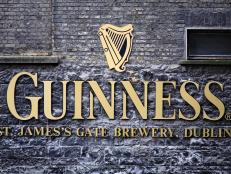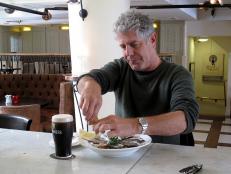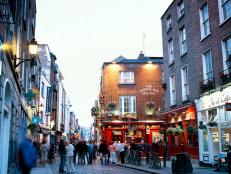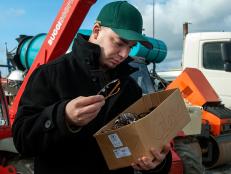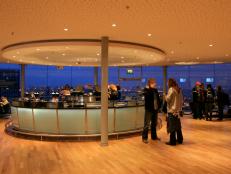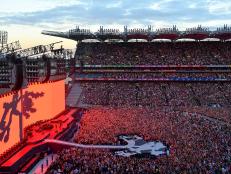Things to Do in Dublin
The Irish capital brims with energy, character, and a slew of activities and captivating sights. Explore Dublin's historic, artistic, literary and liquid attractions.
By:
Aefa Mulholland
Related To:
lessRelated To:
View The Gallery
1 / 12
Guinness Storehouse
One of two main stops on any brew to-do list in Dublin, St. James's Gate is the home of Guinness, and, as a result of all the thirsty visitors pouring into the city, the Guinness Storehouse is the country's most popular attraction. Tours, tastings and Guinness-pouring master classes are all part of the allure.
Old Jameson Distillery
If you've finished your pint, move to the north side of the river and to the next round at the Old Jameson Distillery in Dublin's old horse market area, Smithfield. Jameson's legendary triple-distilled drams are on offer at the end of tours, but if you prefer to hot the bottle right away, there's a bar and restaurant on premises, too.
Christ Church Cathedral
Founded in the year 1028, the Cathedral remains an important part of Ireland's religious life and identity. A vast medieval crypt lurks underneath and ghoulish sights, such as the heart of Dublin's patron saint, Lawrence O'Toole, and a mummified cat and rat, are on show.
Grafton Street
The heart of Dublin's traditional shopping district, the half dozen short, colorful blocks that make up Grafton Street are crammed with shoppers, strollers, buskers and tourists ambling the pedestrian street from Trinity College up to leafy Stephen's Green. No visit is complete without a stop at legendary "clattery café," Bewley's, for tea and a bun.
National Museum of Ireland
Actually a trio of impressive institutions, the National Museum of Ireland is divided between three locations; Kildare Street's Archeology and History Museum, Merrion Square's Natural History Museum and the riverside's Decorative Arts and History Museum. Almost unchanged since it opened in 1857, and nicknamed the “Dead Zoo” by Dubliners on account of its ancient collection of 10,000 stuffed, pickled and otherwise preserved creatures, the Victorian Natural History branch is perhaps the most atmospheric.
National Gallery of Ireland
Like the trio of National Museums, the National Gallery is free to visit. With masterpieces dating back to the Renaissance and a fine collection of Irish art through the ages, the grand, airy building sits on Merrion Square, close to Trinity College and the National Museum.
Dalkey Neighborhood
Once a charming fishing village outside Dublin, Dalkey is now one of the city's priciest neighborhoods, home to celebrities, reached by a scenic ride south on the swift DART train. The village offers some lovely, breezy, coastal strolls, plus charming pubs, such as Finnegan's and The Queen's, where U2's Bono often pops in for a pint.
Temple Bar
Temple Bar -- a cobbled street parallel to the River Liffey -- is a colorful 10-block stretch, crammed with restaurants, cafes, galleries and traditional pubs with people and music spilling out. Crowds pack the narrow street, which is actually comprised of Temple Bar, plus a few blocks of both Fleet Street and Essex Street East. Those who follow the street west across Parliament Street will be rewarded by encountering the quieter, quirkier Cow's Lane with its incredible cake cafe, design stores and excellent bookshop, The Gutter.
Dublin Castle
Dating back to the year 1204, Dublin Castle is not an ancient-looking castle, but one with a hodge-podge of interesting corners. Visit the stately State Apartments, the Viking defense bank, the Gothic Chapel Royal and the lofty Chester Beatty Library, with its impressive Middle Eastern, Asian and North African paintings, manuscripts and prints, plus the Library's hidden gems, the Silk Road Cafe and secret roof garden.
The Book of Kells at Trinity College
A visit to view the 9th century, painstakingly handwritten and decorated manuscript, the Book of Kells, is a two-in-one since the ancient tome is kept in Trinity College Dublin's stunning Old Library. The cobble stone squares and elegant colleges of Trinity, alma mater of Irish luminaries such as Oscar Wilde, Bram Stoker ("Dracula") and Jonathan Swift ("Gulliver's Travels"), date back to the year 1592.
O'Connell Street
A grand, broad thoroughfare stretching north from the River Liffey, O'Connell Street had a pivotal place in Irish history. Among other events, the street's General Post Office bore the brunt of bombardment during 1916s Easter Rising; bullet holes still scar pillars. O'Connell Street also boasts the gleaming Spire, the world's tallest sculpture, at 398-feet high.
Old Kilmainham Gaol
Book ahead for tours of the Old Kilmainham Gaol jail that held heroes of Ireland's fight for independence from the 1780s to the 1920s, in addition to regular Dubliners including 7-year-old children arrested for petty theft. The eerie cells and execution sites might make your hair stand on end. More recently, the jail has starred as the location for movies, including "The Italian Job", "In the Name of the Father" and "Michael Collins."
